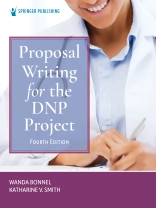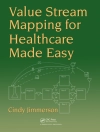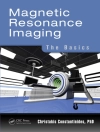Helps readers envision ‘the big picture’ of their project from start to finish
Now in its fourth edition, this acclaimed text has helped thousands of students craft well-written, high-caliber DNP Project proposals. It is distinguished by a concise, accessible approach grounded in the authors’ Project Triangle, a proven, step-by-step framework that helps students organize and complete quality proposals. Retaining the approach that guided previous readers toward project success, the fourth edition has been expanded and updated to reflect present nursing scholarship. It addresses practice scholarship in greater detail, emphasizes academic/practice connections, focuses on working with clinical mentors, and discusses opportunities for documenting practicum products. The resource guides readers in addressing and naming select student outcomes/competencies, substantially incorporates AACN Essentials and APN competencies, and offers increased focus on quality improvement. The text also examines the time frame for specific project benchmarks and incorporates more ‘Tips Boxes’ throughout.
The book—supporting both students and faculty—offers practical guidelines for diverse clinical project models and fosters the development of concise, cohesive proposals that buttress the entire project. Activities throughout the text address important concepts and aid students in enhancing their skill sets in planning, writing, and implementing clinical project proposals. Helpful features include objectives and reflective questions to focus the student on key topics, abundant examples and pointers, self-assessments including goal-setting tips, examples of successful student work showcasing samples of ‘student problems and resolutions, ‘ interactive exercises to stimulate creative thinking, and exemplars of quality improvement projects.
New to the Fourth Edition:
- Emphasizes academic/practice connections
- Addresses practice scholarship in significant detail
- Helps readers to identify and address select student outcomes/competencies
- Focuses on working with clinical mentors and opportunities to document practicum projects
- Covers time frame for specific project benchmarks
- Expands use of popular ‘Tip Boxes’ throughout
- Thoroughly integrates AACN Essentials and APN competencies
- Spotlights quality improvement, a core of many DNP projects
Key Features:
- Provides complete coverage of requirements for a successful DNP project
- Based on a proven methodology for step-by-step project guidance
- Includes numerous examples and helpful tips
- Supports diverse clinical project topics
- Includes reflective questions to promote creative thinking and interactive exercises to promote student engagement
- Offers opportunities for self-assessment to help students move smoothly through the process
- Helps students through roadblocks with sample ‘student problems and resolutions’
- Provides Quality Improvement project exemplars
Содержание
Contributors for Proposal Abstracts and Project Examples
Preface
Acknowledgments
Instructor Resources
Section I: Writing Your Proposal: Putting Your ‘Problem’ in Context
Chapter 1: Introduction: Why a Scholarly Proposal for the Clinical Project?
Chapter 2: Using the Writing Plan as a Developmental Tool for the Advanced Clinical Project
Chapter 3: Writing A Good Clinical Problem Statement And Gaining Project Context
Chapter 4: Clinical Projects and Quality Improvement: Thinking ‘Big Picture’
Chapter 5: Into the Literature: Gaining Best Evidence and Relevant Literature
Chapter 6: Synthesizing Best Evidence and Literature Review
Chapter 7: Framing the Advanced Clinical Project With Relevant Clinical Frameworks
Section II: Writing Your Proposal: Designing and Setting the Stage for Your Project
Chapter 8: Addressing Outcomes Evaluation in the Advanced Clinical Project Proposal
Chapter 9: Guiding the Advanced Clinical Project: The Purpose of a Purpose Statement
Chapter 10: Mapping It Out: From Problem to Advanced Clinical Project Plan
Chapter 11: Writing the Methods Section: Organizing the Advanced Clinical Project Proposal
Chapter 12: Gaining Credible Clinical Project Data: Being Systematic and Objective
Section III: Writing Your Proposal: Adding the Detail for Proposal Completion
Chapter 13: Writing the Data-Analysis Plans for Advanced Clinical Projects
Chapter 14: Keeping Clinical Projects Ethical and Dependable
Chapter 15: Finalizing the Proposal as a Professional Document: Reviewing, Editing, and Revising
Section IV: Finalizing Your Proposal and Project: Next Steps
Chapter 16: Moving the Proposal to Completed Project
Chapter 17: Moving the Proposal to Written Final Report
Chapter 18: Moving Your Completed Project to Dissemination and Further Scholarship
Appendices
A. Project Triangle Model
B. Checklist for Planning or Self-Assessment of a Specific Project
C. Proposal Abstract: ‘Improving the Care of Patients With Chronic Kidney Disease Using Evidence-Based Guidelines’
D. Proposal Abstract: ‘Improving Diabetes Care Delivery in an Integrated Health Clinic’
E. Project Abstract: ‘Unit-Based Council Chairs’ Perception of Unit-Based Councils’
F. Proposal Abstract: ‘Descriptive Evidence Generating: Learning From Practitioner Owners of Clinics in Missouri’
G. Proposal Abstract: ‘Evidence Synthesis Plus: Anesthesia Considerations and Implications for Obese Pediatric Patients’
H. Proposal Abstract: ‘Evidence-Based Quality Improvement: Improving the Communication of Clinical Information Between Nurses and Physicians in Long-Term Care’
Index
Об авторе
Katharine V. Smith, Ph D, RN, is associate professor emeritus at the University of Missouri Kansas City School of Nursing and Health Studies. Dr. Smith has received multiple grants, most of which have focused on aspects of teaching, advanced education, and nursing traineeships. Recent scholarship includes peer viewed publications and national presentations on the use of simulation to teach legal and ethical content. She has also coauthored the textbook Teaching Technologies in Nursing and the Health Professions (2019). Dr. Smith has taught in both undergraduate and graduate nursing programs, facilitating advanced clinical projects through the early conceptual phases.












